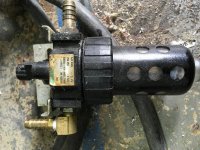Hi everyone, I'm a long time lurker but this is my first post.
I work at a startup company in the Portland, OR area that is developing a new type of glucose monitor.
We have a 1985 Kitamura MyCenter 1 and the main spindle bearing seems to have been cooked due to inadequate lubrication.
We've talked with some shops in the area about having the spindle repaired, but we wanted to check here just in case anybody has a MyCenter 1 that they're parting out and has a known working spindle to sell, before we go ahead with a repair or a used replacement. Can't hurt, right?
Sol
I work at a startup company in the Portland, OR area that is developing a new type of glucose monitor.
We have a 1985 Kitamura MyCenter 1 and the main spindle bearing seems to have been cooked due to inadequate lubrication.
We've talked with some shops in the area about having the spindle repaired, but we wanted to check here just in case anybody has a MyCenter 1 that they're parting out and has a known working spindle to sell, before we go ahead with a repair or a used replacement. Can't hurt, right?
Sol

















